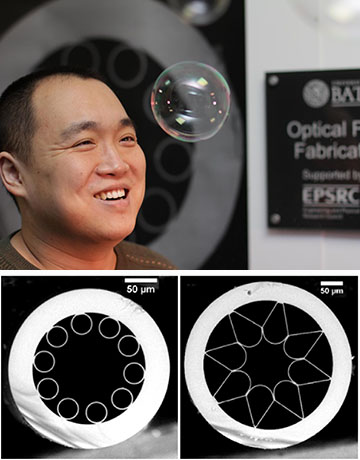
(Top) Fei Yu, a coauthor on the new University of Bath study that uses the “gas-filled bubble” of hollow-core fiber in a new laser design. [Image: University of Bath] (Bottom) SEM cross-sectional images of the hollow-core fiber used for the main gain cavity (left) and the feedback loop (right). [Image: M.R. Abu Hassan et al., Optica, doi: 10.1364/OPTICA.3.000218]
Scientists at the University of Bath, U.K., have demonstrated a novel laser design that marries the characteristics of fiber and gas lasers, and that provides continuous and pulsed operation at the difficult-to-reach, but coveted, mid-infrared wavelength zone of 3.1-3.2 μm (Optica, doi: 10.1364/OPTICA.3.000218). The team believes that the technique—which involves pumping of a gas-filled, hollow-core-fiber cavity with inexpensive, off-the-shelf telecom-wavelength laser diodes—should scale well to high power levels, and be adaptable to longer-wavelength operation via other gain media.
Wavelength gap
The mid-IR wavelength band has numerous potential applications in environmental sensing and security (see, for example, “Air-Quality Monitoring in the Mid-Infrared,” Optics & Photonics News, November 2015). But practical, field-ready lasers in the range from 3.0 to 3.5 μm have proved maddeningly difficult to implement.
That’s because solid-core silica fiber lasers, which have shown terrific performance up to 2.5 μm, start to become strongly absorbing above those wavelengths, which limits their potential power. Meanwhile, continuous-wave, room-temperature operation for quantum cascade lasers—another mid-IR workhorse technology—has proved a tough proposition for wavelengths below 3.5 μm. Traditional gas lasers can operate here, but tend to be bulky and inefficient, and thus difficult to apply in field situations.
A fiber-gas marriage
To get past the roadblock, the Bath team, led by William Wadsworth and Jonathan Knight, put the best qualities of fiber lasers and gas lasers together in a single package. They began with a new family of hollow-core glass fibers, which act as a laser cavity—and which boast attenuations as much as four orders of magnitude less than bulk silica in the 3-to-4-μm spectral band. They packed the core of this fiber, at low pressure, with acetylene gas, known to act as a gain medium in the mid-IR area when pumped at telecom wavelengths of 1,530 nm.
That pump wavelength allowed the team to use inexpensive, standard telecom laser diodes as the main pump source. A final component of the system was a second, shorter length of gas-filled feedback fiber, which siphons off a portion of the light in the main fiber to provide amplification and reduce the required pump power.
CW and pulsed operation
The result is a hollow cavity that effectively confines light and allows strong gain and lasing in the 3.1-to-3.2-μm spectral band. The team reported efficient results in both continuous-wave operation and pulsed operation at a repetition rate of 2.6 MHz. What’s more, according to the Bath scientists, the system in principle can be extended to lasing wavelengths of up to 5 μm through the use of other gas species as gain media, and offers some of the advantages of fiber lasers, such as compactness and low cost, without the power loss at these mid-IR wavelengths. That suggests a place for the Bath approach in applications, such as environmental sensing and explosives detection, where size and flexibility are key considerations.
